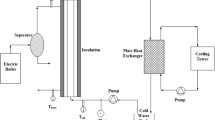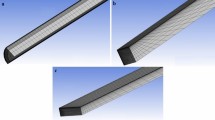Abstract
The high cost of producing nanofluids and setting a high-technology experimental setup have led the researchers to use numerical simulations to investigate the effects of nanofluids on heat transfer. In this study, a representative Computational Fluid Dynamics (CFD) analysis by means of ANSYS-Fluent was performed to show the effects of Al2O3/water nanofluid on average heat transfer coefficient, for the case of flowing fluid through a square cross-sectional duct with single- and two-phase models. For 0.5% Al2O3/water nanofluid, the average deviation rate of the single-phase homogeneous model was 3.35%, whereas Eulerian Mixture Model (EMM) yielded an average result that was 19.87% higher than the reference experimental results. Similarly, for 1.5% and 2.5% Al2O3/water nanofluid, the average deviation rate of the single-phase homogeneous model was found to be 5.25%, %3.35, whereas the EMM yielded an average result, which was 39.59%, 49.47% higher than the reference experimental results, respectively. The comparison of the numerical results from different phase models with the reference experimental data showed that Single Phase Homogenous Model (SPHM) produced closer results to than EMM. The reason behind the high deviation rate from the reference experimental results was found to be the thermal conductivity equation. The thermal conductivity equation in the two-phase EMM was replaced with the Maxwell thermal conductivity equation. By this replacement, for EMM-II model for 0.5%, %1,5 and %2.5 Al2O3/water nanofluid, the average deviation rate from the reference experimental data was found to be 17%, 2.61% and %3.8. The reinterpreted EMM was observed to be the model that gives the closest results to the reference experimental data.











Similar content being viewed by others
Abbreviations
- k :
-
Thermal conductivity [W m-1 K-1]
- φ :
-
Volume fraction
- ρ :
-
Density [kg m-3]
- Cp :
-
Specific heat [J kg-1 K-1]
- T :
-
Temperature [K]
- D:
-
Particle diameter [mm]
- μ:
-
Dynamic viscosity [kg m-1 s-1]
- \(\nabla\) :
-
Gradient operator [-]
- P :
-
Pressure [Pa]
- \(\vec{\upsilon }\) :
-
Vectorial speed [m s-1]
- V :
-
Speed [m s-1]
- Re:
-
Reynolds number [-]
- \(\vec{a}\) :
-
Acceleration [m s-2]
- i :
-
Enthalpy [kJ kg-1]
- L :
-
Duct length [mm]
- a:
-
Duct height [mm]
- W:
-
Watt (N m s-1)
- Nu:
-
Nusselt number [-]
- Pr:
-
Prandtl number [-]
- \(D_{\text{h}}\) :
-
Hydraulic diameter [mm]
- \(\Delta p\) :
-
Pressure change [N m-2]
- \(f_{D}\) :
-
Friction factor [-]
- pe :
-
Peclet number [-]
- \(\overline{U}\) :
-
Average fluid velocity [m s-1]
- \(h\) :
-
Heat transfer coefficient [W m-2K-1]
- \(q\) :
-
Heat flux [W m-2]
- \(f_{\text{drag}}\) :
-
Drag coefficient in Eulerian–mixture model
- nf :
-
Nanofluid
- bf :
-
Base fluid
- p :
-
Nanoparticle
- br :
-
Brownian
- eff :
-
Effective property
- m:
-
Mixture
- dr :
-
Drag
- avg :
-
Average
- w :
-
Wall
- i :
-
Inlet
- o:
-
Outlet
- Al2O3 :
-
Aluminum oxide
- TiO2 :
-
Titanium dioxide
- SiO2 :
-
Silicon dioxide
- VOF:
-
Volume-of-fluid method
- CFD:
-
Computational fluid dynamics
- EMM:
-
Two-Phase Eulerian–mixture model
- EMM-II:
-
Two-Phase Eulerian–mixture model (reinterpreted)
- SPHM:
-
Single-Phase homogeneous model
References
Choi SU, Eastman JA. Enhancing thermal conductivity of fluids with nanoparticles. (No. ANL/MSD/CP—84938; CONF-951135—29), Argonne National Lab., IL United States. 1995.
Sadeghi A, Amini Y, Hassan Saidi M, Chakraborty S. Numerical modeling of surface reaction kinetics in electrokinetically actuated microfluidic devices. Anal Chim Acta. 2014;838:64–75.
Sadeghi A, Amini Y, Hassan Saidi M, Yavari H. Shear-Rate-Dependent rheology effects on mass transport and surface reactions in biomicrofluidic devices. AIChE. 2015;61(6):1912–24.
Amiri Delouei A, Sajjadi H, Izadi M, Mohebbi R. The simultaneous effects of nanoparticles and ultrasonic vibration on inlet turbulent flow: an experimental study. Appl Therm Eng. 2019;146:268–77.
Amiri Delouei A, Sajjadi H, Mohebbi R, Izadi M. Experimental study on inlet turbulent flow under ultrasonic vibration: Pressure drop and heat transfer enhancement. Ultrason Sonochem. 2019;51:151–9. https://doi.org/10.1016/j.ultsonch.2018.10.032.
Sheikholeslami M. New computational approach for exergy and entropy analysis of nanofluid under the impact of Lorentz force through a porous media. Comput Methods Appl Mech Engrg. 2019;344:319–33.
Izadi M, Mohebbi R, Amiri Delouei A, Sajjadi H. Natural convection of a magnetizable hybrid nanofluid inside a porous enclosure subjected to two variable magnetic fields. Int Journal of Mechanical Sciences. 2019;151:154–69.
Ting HH, Hou SS. Investigation of laminar convective heat transfer for Al2O3-water nanofluids flowing through a square cross-section duct with a constant heat flux. Materials. 2015;8:5321–35.
Sheikholeslami M, Rezaeianjouybari B, Darzi M, Shafee A, Li Z, Nguyen TK. Application of nano-refrigerant for boiling heat transfer enhancement employing an experimental study. Int J Heat Mass Transf. 2019;141:974–80.
Sheikholeslami M, Jafaryar M, Shafee A, Babazadeh H. Acceleration of discharge process of clean energy storage unit with insertion of porous foam considering nanoparticle enhanced paraffin. J Clean Prod. 2020;261: 121206.
Sajjadi H, Mohammadifar H, Amiri DA. Investigation of the effect of the internal heating system position on heat transfer rate utilizing Cu/water nanofluid. J Therm Anal Calorim. 2020;139:2035–54.
Wen D, Ding Y. Experimental investigation into convective heat transfer of nanofluids at the entrance region under laminar flow conditions. Int J of Heat Mass Transfer. 2004;47(24):5181–8.
Azari A, Kalbasi M, Derakhshandeh M, Rahimi M. An experimental study on nanofluids convective heat transfer through a straight tube under constant heat flux. Chinese J Chemical Eng. 2013;21(10):1082–8.
Heris SZ, Etemad SG, Esfahany MN. Experimental investigation of oxide nanofluids laminar flow convective heat transfer. Int Communicat in Heat and Mass Trans. 2006;33(4):529–35.
Heris SZ, Nassan TH, Noie SH, Sardarabadi H, Sardarabadi M. Laminar convective heat transfer of Al2O3/water nanofluid through square cross-sectional duct. Int J of Heat and Fluid Flow. 2013;44:375–82.
Esfe MH, Saedodin S, Mahmoodi M. Experimental studies on the convective heat transfer performance and thermophysical properties of MgO–water nanofluid under turbulent flow. Exp Thermal and Fluid. 2014;52:68–78.
Li Q, Xuan Y. Convective heat transfer and flow characteristics of Cu-water nanofluid. Science in China Series E: Tech Sci. 2002;45(4):408–16.
Purohit N, Purohit VA, Purohit K. Assessment of nanofluids for laminar convective heat transfer: A numerical study. Engineering Sci and Tech an Int J. 2016;19(1):574–86.
Özerinç S, Yazıcıoğlu AG, Kakaç S. Numerical analysis of laminar forced convection with temperature-dependent thermal conductivity of nanofluids and thermal dispersion. Int J of Thermal Sci. 2012;62:138–48.
Tahir S, Mital M. Numerical investigation of laminar nanofluid developing flow and heat transfer in a circular channel. Appl Therm Eng. 2012;39:8–14.
Davarnejad R, Jamshidzadeh M. CFD modeling of heat transfer performance of MgO-water nanofluid under turbulent flow. Eng Sci and Tech an Int J. 2015;18(4):536–42.
Behzadmehr A, Saffar-Avval M, Galanis N. Prediction of turbulent forced convection of a nanofluid in a tube with uniform heat flux using a two phase approach. Int J of Heat and Fluid Flow. 2007;28(2):211–9.
Lotfi R, Saboohi Y, Rashidi AM. Numerical study of forced convective heat transfer of nanofluids: comparison of different approaches. Int Comm in Heat and Mass Trans. 2010;37(1):74–8.
Beheshti A, Moraveji MK, Hejazian M. Comparative numerical study of nanofluid heat transfer through an annular channel. Numerical Heat Trans, Part A: Appl. 2015;67(1):100–17.
Bianco V, Chiacchio F, Manca O, Nardini S. Numerical investigation of nanofluids forced convection in circular tubes. Appl Therm Eng. 2009;29(17):3632–42.
Moraveji MK, Ardehali RM. CFD modeling (comparing single and two-phase approaches) on thermal performance of Al2O3/water nanofluid in mini-channel heat sink. Int Communicat Heat Mass Trans. 2013;44:157–64.
Akgul BM. Nanoakışlarda Isı ve Kütle Transferi, Doktora Tezi, Fen Bilimleri Enstitüsü, Celal Bayar Üniversitesi. 2013.
Sekrani G, Poncet S, Proulx P. Modeling of convective turbulent heat transfer of water-based Al2O3 nanofluids in uniformly heated pipe. Chemical Eng Sci. 2018;176:205–19.
Mojarrad MS, Keshavarz A, Shokouhi A. Nanofluids thermal behavior analysis using a new dispersion model along with single-phase. Heat and Mass Trans. 2013;49(9):1333–43.
Albojamal A, Vafai K. Analysis of single phase, discrete and mixture models in predicting nanofluid transport. Int J of Heat and Mass Trans. 2017;114:225–37.
Akbari M, Galanis N, Behzadmehr A. Comparative assessment of single and two-phase models for numerical studies of nanofluid turbulent forced convection. Int J of Heat and Fluid Flow. 2012;37:136–46.
Goktepe S, Atalık K, Ertürk H. Comparison of single and two-phase models for nanofluid convection at the entrance of a uniformly heated tube. Int J of Therm Sci. 2014;80:83–92.
Kahani M. Simulation of nanofluid flow through rectangular microchannel by modified thermal dispersion model. Heat Trans Eng. 2020;41(4):377–92.
Maxwell JC. A treatise on electricity and magnetism, Clarendon press. 1881;1.
Einstein A. A new determination of molecular dimensions. Ann Phys. 1906;19(2):289–306.
Pak BC, Cho YI. Hydrodynamic and heat transfer study of dispersed fluids with submicron metallic oxide particles. Exp Heat Trans Int. 1998;11(2):151–70.
Xuan Y, Li Q. Heat transfer enhancement of nanofluids. Int J of Heat Fluid Flow. 2000;21(1):58–64.
Selvakumar RD, Dhinakaran S. Forced convective heat transfer of nanofluids around a circular bluff body with the effects of slip velocity using a multi-phase mixture model. Int J of Heat Mass Trans. 2017;106:816–28.
Manninen M, Taivassalo V, Kallio S. On the mixture model for multiphase flow. Techn Research Centre of Finland, Finland. 1996.
Schiller L, Naumann A. A drag coefficient correlation Vdi Zeitung. 1935;7:318–20.
Hussein MA, Bakar AR, Kadirgama K. Study of forced convection nanofluid heat transfer in the automotive cooling system. Case Studies in Therm Eng. 2014;2:50–61.
Acknowledgements
This study is derived from the master's thesis, entitled “Numerical investigation of nanofluid flow and heat transfer by single-phase and two-phase methods”.
Author information
Authors and Affiliations
Corresponding author
Additional information
Publisher's Note
Springer Nature remains neutral with regard to jurisdictional claims in published maps and institutional affiliations.
Rights and permissions
Springer Nature or its licensor holds exclusive rights to this article under a publishing agreement with the author(s) or other rightsholder(s); author self-archiving of the accepted manuscript version of this article is solely governed by the terms of such publishing agreement and applicable law.
About this article
Cite this article
Ozgen, F., Kamaci, G. Numerical heat transfer from Al2O3/water nanofluid through square cross-sectional duct with single- and two-phase models. J Therm Anal Calorim 147, 13483–13498 (2022). https://doi.org/10.1007/s10973-022-11539-6
Received:
Accepted:
Published:
Issue Date:
DOI: https://doi.org/10.1007/s10973-022-11539-6




